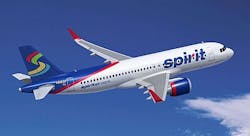2012 promises to be a tough year for commercial airlines, as 2011 capacity exceeds demand
GENEVA, Switzerland, 5 Feb. 2012. Worldwide airline passenger traffic rose 5.9 percent in 2011 compared to the previous year, yet worldwide commercial air cargo traffic shrunk by 0.7 percent over the same period last year, report officials of the International Air Transport Association (IATA) in Geneva, Switzerland.
Despite the growth in commercial airline passenger traffic, however, growth in commercial airline passenger capacity in 2011 grew by 6.3 percent, causing supply to exceed demand during the past calendar year, IATA officials say. Worldwide commercial airline cargo capacity, likewise, grew by 4.1 percent in 2011, causing commercial air cargo capacity to exceed demand., putting downward pressure on load factors.
The average passenger load factor worldwide for 2011 was 78.1 percent, down from 78.3 percent in 2010, while the freight load factor was 45.9 percent, down from 48.1 percent in 2010, IATA officials report.
Related stories
Passenger traffic slows down during June, IATA says
IATA officials say February air passenger traffic was slowed due to political turmoil
From curb to gate without lines, disrobing, or searches is goal of IATA checkpoint of the future.
"Healthy passenger growth, primarily in the first half of the year, was offset by a declining cargo market," says Tony Tyler, IATA’s director general and chief executive officer. "2012 is still going to be a tough year." Passenger demand for December 2011 rose 5.4 percent compared to the same month in 2010.
International air travel rose 6.9 percent in 2011, most of the growth coming in the first half of the year. International capacity climbed 8.2 percent, pushing the passenger load factor down to 77.4 percent, IATA officials say. For December, international traffic climbed 6.4 percent year over year, in part owing to depressed traffic levels in 2010 in North American and Europe, and rose 1.4 percent compared to November.
European carriers posted the second highest growth rates, behind Latin American carriers. European demand rose 9.5 percent last year while capacity climbed 10.2 percent, resulting in a load factor of 78.9 percent.
North American carriers had the industry’s highest load factors for the year at 80.7 percent. Latin American airlines led the industry in traffic growth in 2011 with a 10.2 percent rise in demand compared to 2010.
Middle Eastern carrier traffic rose 8.9 percent for the year, against a 9.7 percent climb in capacity, putting pressure on load factors, which at 75.4 percent, was the lowest except for Africa. Airlines in this region have slowed the pace at which they have expanded but price competitive products and geographically well-positioned hubs are enabling Middle East carriers to continue to improve their share of long-haul markets, IATA officials say.
Asia-Pacific airlines experienced the widest traffic and capacity gap for the year, with annual traffic up 4.1 percent versus a 6.4 percent climb in capacity.
Passenger demand in domestic markets in 2011 rose 4.2 percent compared to a 3.1 percent rise in capacity, leading to a load factor of 79.3 percent. Demand in the United States rose 1.3 percent for the year. Load factors led the industry at 83 percent, helping to boost airline unit revenues.
Chinese domestic demand rose 10.9 percent for the year on a 7.8 percent lift in capacity, strengthening load factors to 82.2 percent. India had the strongest annual growth with demand up 16.4 percent but capacity rose 18.6 percent and the load factor was 74.7 percent.
Brazilian carriers saw a 13.7 percent jump in demand from their home market last year on an 11.2 percent rise in capacity. Load factors remain below the industry average at 69.3 percent. For more information contact IATA online at www.iata.org.
About the Author
John Keller
Editor-in-Chief
John Keller is the Editor-in-Chief, Military & Aerospace Electronics Magazine--provides extensive coverage and analysis of enabling electronics and optoelectronic technologies in military, space and commercial aviation applications. John has been a member of the Military & Aerospace Electronics staff since 1989 and chief editor since 1995.
